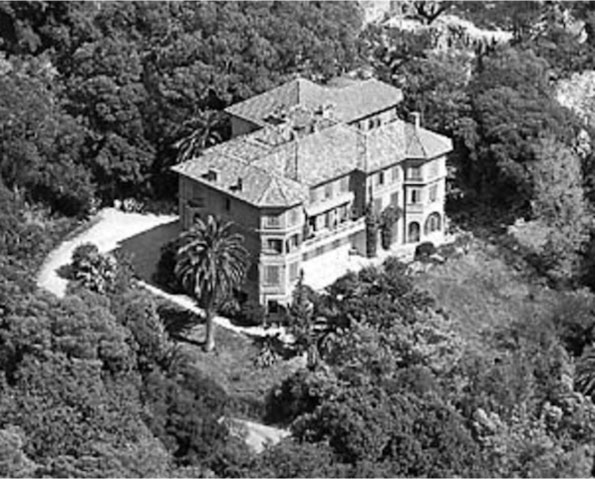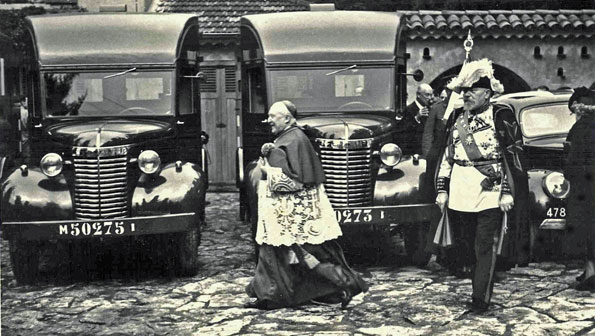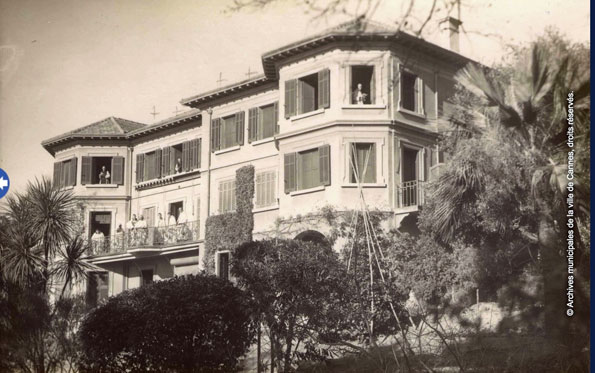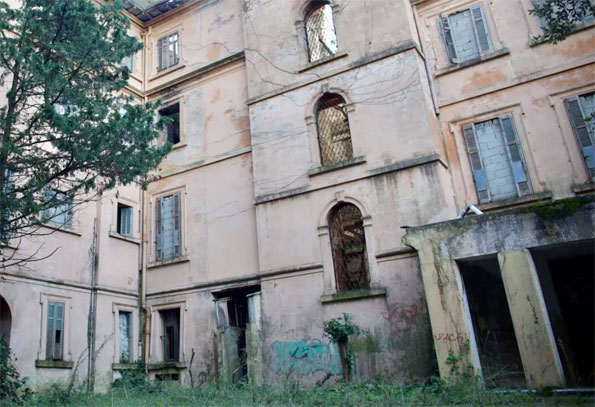The English Riviera
Lord Derby and the Lost Villa
In the spring of 1939, the entrepreneur Philippe Erlanger persuaded the French government that the time had come for France to host its own national film festival and that the chosen town should be Cannes. The proposed opening date was 1st September of that year and the venue was to be the pretty wedding cake casino on the Croisette near the old port. In spite of the increasing threat of war, Cannes tossed its head and continued with the preparations. With summer came the stars. Gary Cooper, Tyrone Power and Edward G. Robinson strolled the Croisette. In Antibes the film producer Alexander Korda married the Hollywood actress Merle Oberon, who had starred with Laurence Olivier in Wuthering Heights. The Riviera was holding its own.
On the 22nd August the Bal des Petits Lits Blancs, one of the most important charity balls of the French social season, was held at the Palm Beach Club at the eastern end of the Croisette. The occasion proved to be a last concerted display of wealth and sophistication. Fabulous fancy-dress costumes and dazzling jewels adorned the rich and famous. Gaiety and laughter filled the great reception rooms, although the guests were somewhat subdued during the course of the evening by an uneasy omen – one of the worst summer storms the coast had ever known. On the following day the non-aggression pact between Germany and Soviet Russia was announced, which boded ill and resulted in a mass exodus of alarmed visitors. Within the week the neon signs, announcing the birth of what would one day become the most famous film festival in the world, were turned off and would not be re-lit for six years.
The safe, privileged world of the Riviera expatriate community became one of unease and bewilderment. Everyone was now living in the Phoney War of 1939 to early 1940 and virtually everyone who was anyone, and who had stayed on, was involved in an aid programme or on a committee, sometimes on several at the same time. In October of 1939 a mainly expatriate group, which encompassed some of the great and good on the coast met at the Villa Montfleury on the Avenue des Oliviers in Cannes.
The newly founded Anglo-American Corps of Cannes invited Lord Derby to act as President. The 17th Earl of Derby, Edward George Stanley, was a British ex-secretary of state for war, who had also been appointed as ambassador to France from 1918 to 1920. His ancestor, the12th Earl, had founded the famous Derby Race at Epsom in England, still one of the most important events on the racing calendar. The family were large landowners in the north of England, the family seat being Knowsley Hall in Merseyside.
In 1889 Lord Derby had married Alice Montagu, daughter of the 7th Duke of Manchester and the German-born Countess von Alten. They had a daughter and two sons, Edward and Oliver. There seems no doubt that the Derbys loved their Riviera home, the Villa Sansovino, which they bought in 1924, having visited the area regularly since the beginning of the 1900s. Derby became a benefactor much involved with Cannes and would eventually be made a Citoyen d’Honneur of the town. In 1895 he, along with several friends, created the well-known golf course at Valescure, high in the hills above St Raphael in a forest of umbrella pines.
Derby was a forceful character well placed to preside over the newly formed Anglo-American corps. He had a famously short sharp altercation in 1928 with the Bishop of Gibraltar regarding the four Anglican churches in Cannes. The Bishop had decreed that due to cost St George’s, built in memory of Queen Victoria’s son the Duke of Albany, should be the one to be closed. The Duke had died in Cannes of haemophilia in 1884 at the age of 30. In a furious letter to the Archbishop of Canterbury’s secretary, Derby declared that ‘the Bishop must be stupid to talk like this’. He prevailed, as St George’s still stands, albeit now a Catholic church.

The Villa Sansovino, on the Chemin de Caldana in Cannes had been extended several times in the 1920s by the Cannes architect J. Arluc. In 1938 Derby asked the American architect Barry Dierks, who lived on the coast and was much sought after, to remodel the building and add a lift to increase its comfort. The villa, named after Derby’s favourite racehorse, now became even more imposing than before.
Left – The Villa Sansovino
Old typewritten notes, held by the Liverpool City Records Office, list the rooms in the villa. There were 16 for the family, including reception rooms, bedrooms and five bathrooms, and around 15 in the staff quarters, of which five were bedrooms for the men on the first floor and five for the women on the second. There was to be no fraternising. Rooms were designated for ‘ladies’ in the main house, on the servants’ floors the bedrooms were labelled for ‘women’. In 1939 the gardener of Sansovino optimistically ordered many thousands of spring bulbs, such as narcissi, tulips, irises and snowdrops. The gardens must have been enchanting. But they would not be admired for long.
Lord Derby was to run the Ambulance Corps, with the same organised discipline as the Villa Sansovino. With a branch at the Hotel Ruhl in Nice the Corps was set up to provide a fleet of ambulances, each capable of carrying five stretchers or ten sitting cases to be used under the authority of the French military. They aimed at 20 cars, either donated or bought by donated funds, and for this they were linked to the American Field Service in New York, which had done such sterling work in World War I. They asked for Chevrolet cars to be sent from America but before these arrived they had to make do with other vehicles of various shapes, sizes and origin. These included a Citroen Traction, a Mercedes and one of the short-lived Matford Ford F-81 Break de Chasse.
To send them on their way the first ambulances were inaugurated in Cannes and blessed by Monseigneur Paul Remond, the Bishop of Nice, along with the Superintendent of the Order of St. Lazarus of Jerusalem in full regalia. Bishop Remond, at that time a fervent admirer of the Vichy regime, would become one of those courageous members of the Clergy who risked their lives to organise safe houses for Jewish children. Convents, such as Nôtre Dame de Bonne Voyage in Cannes were told to protect Jewish children and their mothers.
Right – ambulances being blessed by the Bishop and the Superintendent of the Order of St. Lazarus of Jerusalem in full regalia.

The ‘front’ to which the Ambulance Corps travelled was Hagondange, a village near Metz and the failed Maginot Line and the ambulances, now augmented by four large converted Chevrolets sent from America, joined other similar groups. Also included was a French mobile field hospital with an X-ray unit, a generating plant and a fully equipped mobile operating theatre. But when the Germans broke through 15 miles to the north there was a rapid withdrawal of both ambulances and field hospital which, along with a constant stream of refugees, fled to relative safety in the south. The fate of the Chevrolets is not recorded.

When the Germans occupied France in May 1940 the country was split into two and the German army, occupying the rest of France, allowed the Italians to ‘caretake’ the southern area, in return for behaving themselves. Those British expatriates who had lagged behind now escaped by whatever means possible. Lord Derby and his wife returned to England and the Villa Sansovino remained in the hands of their gardener and the housekeeper, Celine. Neither the Italians, nor, later, the Germans requisitioned the villa.
Left – The Villa Sansovino during the war
The John Taylor agency whose founder was responsible, along with Lord Henry Brougham, for changing the simple fishing village of Cannes into an elegant holiday destination, now took over the management of Sansovino to the best of their ability. Apart from the ferocious Ovra, the Italian secret police, occupation by the Italians was reasonably benevolent.
However, early in 1943 there was an interesting incident at Sansovino. One Sunday morning the housekeeper Celine received the visit of a group of Italian soldiers who said they wished to search the villa for arms. While she was following a group of soldiers through the house another group opened the cellar and consumed several bottles of Lord Derby’s excellent and carefully chosen wines. The following morning soldiers, accompanied by a small fleet of vehicles, arrived at the villa and began emptying the cellar. An alarmed Celine managed to telephone the John Taylor agency who sent an employee to deal with the situation. This gentleman protested strongly at the purloinment of the wines, took an inventory of the bottles already loaded onto a lorry and demanded a formal requisition order. For his pains he was detained, still protesting, at Italian headquarters until the evening. Finally, he was taken into the officers’ mess and shown the stolen wines, 300 bottles in all. It was arranged they should be returned the following day. When this happened they were promptly bricked up in a recess in the cellar to await the end of the war.
During this agonising time an appeal was sent to Lord Derby in England asking for blankets (presumably from Sansovino) for escaped British soldiers interned in Marseille ‘in a terrible plight’. Derby was not too keen as he felt he might need the blankets later, ‘Still I suppose I must do it’.
When the Germans swept into the south in October 1943 they established a harsh regime which included a terrifying determination to track down and round up the Jewish population who had sought refuge there. As for the monks of the Iles de Lérins, off the Cannes coast, they had been established on the island of St-Honorat for centuries, the order becoming the Cistercian Congregation of the Immaculate Conception in the 19th century. Now they were in the way. They were promptly expelled and the Germans moved in. The order found refuge in Sansovino and stayed in the villa until November 1944, after the south of France had been liberated by American and French forces, aided by Resistance fighters.
Letters now began to flow to England from Cannes, describing how the villa had remained in good order in spite of four years of occupation. The Derbys returned to Cannes in1947, but it was not to be for long, for Lord Derby died at his home in Lancashire in 1948.

Sansovino was eventually bought by Charles de Belgique, the second son of King Albert 1 of the Belgians. Charles owned the villa until the 1960s. Later, abandoned, it became a squat, then the subject of a long-drawn-out planning application which never reached completion. In 1994 the house was set on fire and left to deteriorate, eventually losing its roof and becoming open to the elements, the once lovely gardens overgrown and unkempt. So it stands now – a skeleton of its former elegance and a bygone age.
Time passes, tout change.
© Copyright: Maureen Emerson 2021
